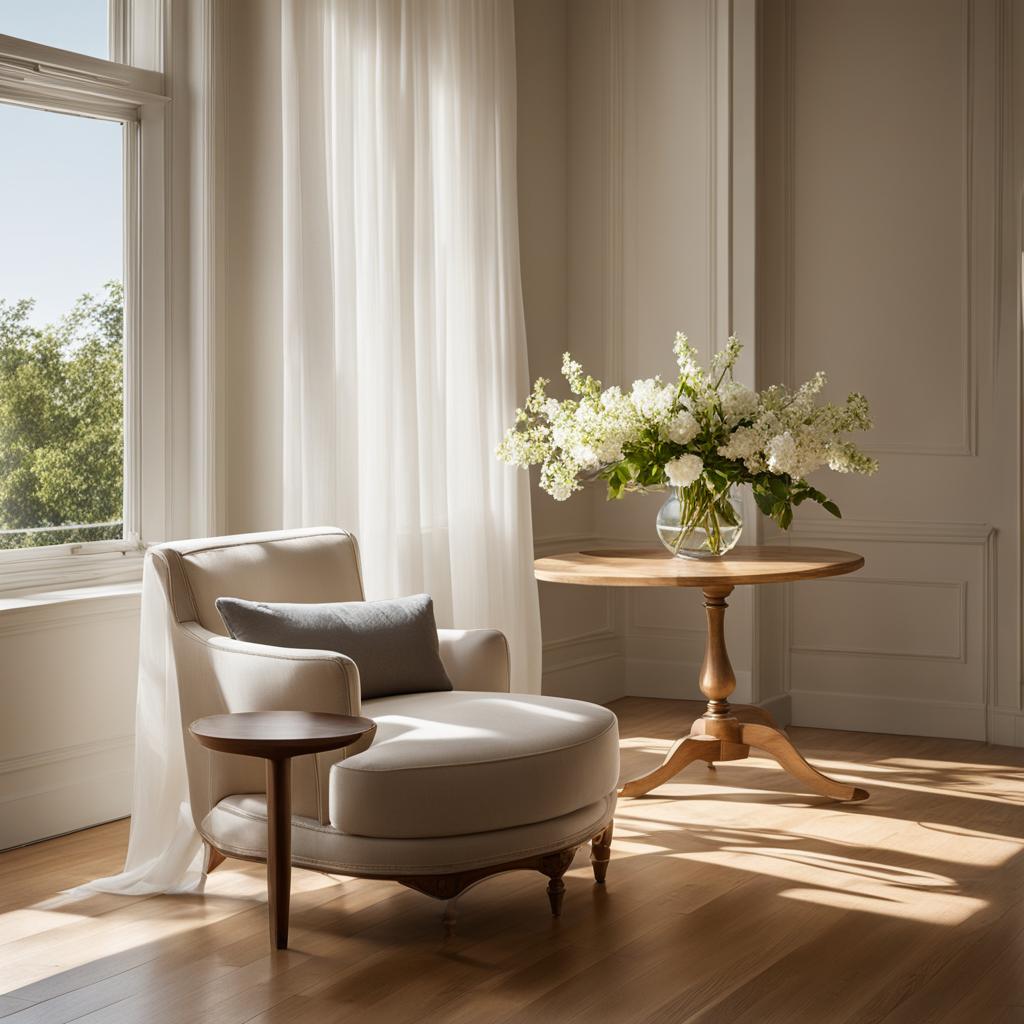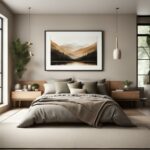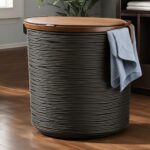Adding color with paint is a quick and easy way to add style and personality to a living room. However, it’s important to choose the right colors for north-facing rooms, which receive limited natural light. In this article, I will explore the best colors for north-facing rooms in 2024, including interior paint colors that can brighten up these spaces and create a warm and inviting atmosphere.
Key Takeaways:
- Beige is a versatile choice that provides a warm and neutral base for north-facing rooms.
- Gray is experiencing a resurgence and can create a contemporary and sophisticated look in these spaces.
- Earthy tones like terracotta and olive green can add warmth and depth to north-facing rooms.
- Light shades of blue can create a calming and soothing atmosphere.
- Soft greens can bring a touch of nature indoors and create a peaceful environment.
- Adding splashes of yellow can bring vibrancy and energy to north-facing rooms.
- Lighter shades of purple can create a serene and relaxing ambiance.
Beige: A Versatile Choice for North Facing Rooms
When it comes to selecting the perfect paint color for your north facing room, beige is a versatile option that can create a warm and inviting atmosphere. Beige is a neutral color that complements various design styles, making it a timeless choice for any space. Whether you prefer light, medium, or dark shades of beige, this color can brighten up your north facing room and enhance the limited natural light it receives.
One of the advantages of using beige paint colors in north facing rooms is their versatility. Beige provides a neutral base that allows other elements in the room to stand out. You can pair beige walls with vibrant accent colors, such as deep blues or rich greens, to create a striking contrast. Alternatively, you can opt for a monochromatic color scheme by incorporating different shades of beige and adding texture through furniture or accessories.
Beige paint colors also have a timeless quality that can withstand changing design trends. Whether you prefer a classic or contemporary aesthetic, beige can adapt to your style and create a cohesive look in your north facing room. By choosing beige as your wall color, you can create a blank canvas that allows you to experiment with different decor elements and easily update your space as desired.
Table: Comparing Different Shades of Beige
| Beige Shade | Description |
|---|---|
| Light Beige | A soft and subtle shade of beige that brightens up the room and creates a sense of airiness. |
| Medium Beige | A warm and inviting shade of beige that adds depth and coziness to the room. |
| Dark Beige | A rich and sophisticated shade of beige that brings a sense of elegance and warmth to the space. |
When choosing the right shade of beige for your north facing room, consider the overall lighting conditions, the size of the space, and the mood you want to create. Lighter shades of beige work well in smaller rooms or spaces with limited natural light, as they can make the room appear larger and brighter. On the other hand, darker shades of beige can add a sense of drama and intimacy to larger rooms.
Embracing Gray: The New Neutral for North Facing Rooms
When it comes to choosing paint colors for north facing rooms, gray is making a comeback as a popular and contemporary choice. Gray paint colors, especially those with cool undertones, can create a chic and sophisticated look in these spaces. From light gray to charcoal, there is a wide range of shades to choose from, allowing you to find the perfect hue to suit your style and preferences. By embracing gray in your north facing room, you can achieve a modern aesthetic that complements the limited natural light.
Gray is a versatile color that can be paired with various accent colors and design elements. You can opt for a monochromatic look by using different shades of gray throughout the room, or you can create contrast by incorporating pops of vibrant colors. Gray also works well with both contemporary and traditional design styles, making it a versatile choice for any north facing room.
One of the key advantages of using gray paint colors is their ability to reflect light, which can help brighten up a north facing room. The cool undertones of gray can create an illusion of brightness, making the space feel more open and airy. Additionally, gray is known for its calming effect, which can make your north facing room feel more peaceful and serene.
Gray Paint Color Ideas for North Facing Rooms
To help you choose the perfect gray paint color for your north facing room, here are some trendy options to consider:
- Light Gray: A pale or light gray shade can create a soft and ethereal atmosphere in your north facing room. This subtle hue adds a touch of elegance and sophistication to the space while still maintaining a sense of warmth.
- Charcoal Gray: If you prefer a more dramatic and bold look, charcoal gray is an excellent choice. This deep shade of gray can add depth and richness to your north facing room, creating a cozy and intimate ambiance.
- Greige: A cross between gray and beige, greige is a popular choice for its versatility. This warm and neutral hue can blend seamlessly with other colors and design elements, making it a perfect choice for a north facing room.
By embracing gray as the new neutral for your north facing room, you can create a stylish and inviting space that maximizes the limited natural light. Whether you choose a light gray, charcoal gray, or greige, this versatile color will surely enhance the overall atmosphere of your north facing room.
Infusing Warmth with Earthy Tones
When it comes to creating a cozy and inviting atmosphere in your north facing room, infusing warmth with earthy tones is a winning strategy. Earthy paint colors, such as terracotta, olive green, and warm browns, can add depth and personality to your space while counterbalancing the coolness often associated with limited natural light.
These natural paint colors bring a sense of nature indoors, creating a grounded and connected feeling within your north facing room. Whether you choose a rich terracotta for a warm and rustic look, a calming olive green for a tranquil ambiance, or warm browns for a cozy and inviting atmosphere, earthy tones can transform your space into a haven of comfort.
“Earthy paint colors bring a sense of nature indoors and create a grounded and connected feeling within your north facing room.”
Pair your earthy wall color with complementary decor elements, such as wooden furniture, woven textiles, and natural materials, to enhance the organic and cozy vibe. These cozy paint colors work well in various rooms, including living rooms, bedrooms, and even home offices, bringing a sense of warmth and tranquility to your everyday life.
Earthy Tones Comparison Table
| Paint Color | Description | Best Use |
|---|---|---|
| Terracotta | A rich and warm hue reminiscent of sun-baked clay. | Living rooms, dining rooms, and bedrooms for a rustic and earthy vibe. |
| Olive Green | A calming and soothing shade inspired by nature. | Bedrooms, home offices, and bathrooms for a tranquil ambiance. |
| Warm Browns | Various shades of warm browns, from light to dark, creating a cozy and inviting atmosphere. | Living rooms, dens, and kitchens for a warm and welcoming feel. |
With earthy tones, you can transform your north facing room into a welcoming and cozy space that embraces nature and provides a sense of tranquility. Whether you choose terracotta, olive green, warm browns, or a combination of these colors, infusing your room with these natural paint colors is sure to create a warm and inviting atmosphere you’ll love coming home to.
Harnessing the Power of Blues
When it comes to choosing paint colors for north facing rooms, harnessing the power of blues can be a game-changer. Blue paint colors bring a calming and soothing atmosphere to these spaces, making them ideal for bedrooms, living rooms, or any area where you want to create a tranquil environment.
Light shades of blue, such as sky blue or baby blue, can make a north facing room feel airy and light-filled. These cool paint colors have a refreshing effect and can create an illusion of more natural light. On the other hand, darker shades of blue, like navy or indigo, can add depth and richness to the room, creating a more dramatic and sophisticated look.
Blue is also a popular choice for coastal-inspired design. Coastal paint colors bring a sense of serenity and relaxation to your north facing room, evoking the feeling of being by the ocean. Pairing blue with white accents or natural textures like wicker or rattan can enhance the coastal vibe and create a truly inviting space.
So, whether you prefer soft and calming blues or bold and vibrant shades, incorporating blue paint colors into your north facing room can transform it into a serene and visually appealing sanctuary.

| Pros | Cons |
|---|---|
| Creates a calming and soothing atmosphere | May feel too cool in rooms with already limited natural light |
| Light shades of blue can make a room feel more spacious and airy | Darker shades of blue may make a room feel smaller and cozier |
| Perfect for coastal-inspired design | May require additional light sources to compensate for limited natural light |
Opting for Soft Greens
When it comes to creating a soothing and peaceful atmosphere in your north facing room, soft greens are an excellent choice. These gentle and muted shades of green can bring a touch of nature indoors and create a tranquil environment. Whether you opt for a soft sage green or a pale mint, these paint colors can infuse your space with a sense of calmness and serenity.
Soft greens work well in various areas of your north facing room. In bedrooms, they can create a peaceful retreat where you can relax and unwind. In bathrooms, they can evoke a spa-like ambiance, making your daily routine feel more luxurious. Even in living rooms, soft green paint colors can add a refreshing and calming touch, creating a harmonious atmosphere for both relaxation and socializing.
To complement the soft greens in your north facing room, consider incorporating natural elements and textures. Elements like wooden furniture, rattan accents, and woven textiles can enhance the organic and serene feel of the space. Additionally, layering textures such as plush rugs and cozy throws can add depth and visual interest.
Creating a Cozy Corner with Soft Greens
If you’re looking to create a cozy reading nook or a peaceful corner in your north facing room, soft greens can help set the mood. Paint the walls in a soft green shade and pair it with a comfortable armchair or chaise lounge. Add a side table and a floor lamp for reading, and accessorize with plush cushions and a warm throw. With soft greens as the backdrop, you can create a tranquil oasis where you can curl up with a good book or enjoy a moment of solitude.
In conclusion, when choosing paint colors for your north facing room, consider opting for soft greens to create a soothing and peaceful atmosphere. These natural and calming shades can transform your space into a serene oasis where you can relax and recharge.
Adding Splashes of Yellow
When it comes to brightening up a north facing room, adding splashes of yellow can do wonders. Yellow paint colors are known for their sunny and vibrant qualities, making them perfect for creating a cheerful and inviting atmosphere. Opt for warm shades of yellow like buttercream or goldenrod to bring warmth and energy to your space.
Incorporating yellow in your north facing room doesn’t have to mean painting all the walls in this bold color. Instead, use yellow as an accent through accessories, artwork, or even a feature wall. This way, you can add pops of color without overwhelming the space. Yellow accents can create a focal point and draw attention to specific areas, adding visual interest to your room.
One of the benefits of using yellow in your north facing room is its ability to reflect light and create a brighter ambiance. The sunny hue can make the space feel more open and airy, counteracting the limited natural light. By strategically placing yellow elements throughout your room, you can create an energetic and vibrant atmosphere that uplifts the entire space.
Quotes:
“I love how the splashes of yellow in my north facing living room bring in so much joy and positivity. It’s like having a ray of sunshine in my home every day!” – Sarah M.
“Adding yellow accents in my north facing bedroom has completely transformed the space. It feels brighter, more energetic, and I wake up to a burst of sunshine every morning!” – Jason L.
Summary:
Incorporating yellow paint colors in your north facing room can brighten up the space and create a cheerful atmosphere. Use yellow as an accent through accessories or a feature wall to add pops of color without overwhelming the room. The sunny hue reflects light and makes the space feel more open and airy. By strategically placing yellow elements throughout your room, you can create an energetic and vibrant ambiance that uplifts the entire space.
| Benefits of Adding Yellow | Examples of Yellow Accents |
|---|---|
|
|
Exploring Lighter Shades of Purple
Lighter shades of purple, such as lavender or lilac, can work beautifully in north facing rooms. These soft and calming paint colors can create a serene and relaxing ambiance, making them ideal for bedrooms or cozy reading nooks. Light purple shades have a soothing effect on the mind and can help create a peaceful retreat within your north facing room. Combined with other light and neutral tones, light purple can brighten up your space while adding a touch of elegance.
If you’re considering incorporating lighter shades of purple into your north facing room, here are a few tips:
- Choose the right shade: Opt for lighter shades of purple, such as lavender, lilac, or mauve. These shades have a softer and more delicate appearance that can enhance the overall brightness of your north facing room.
- Pair with neutral accents: To create a balanced and harmonious look, pair your light purple walls with neutral accents. Consider using light gray, creamy white, or beige furniture and accessories to create a cohesive color palette.
- Add texture and depth: To make your north facing room visually interesting, incorporate different textures and patterns. Consider adding a plush rug, textured throw pillows, or a patterned wallpaper to create depth and dimension.
- Maximize natural light: To further enhance the brightness of your north facing room, make the most of any natural light available. Keep curtains or blinds open during the day to allow sunlight to filter in, and strategically place mirrors to reflect light and create the illusion of a larger space.
By following these tips and incorporating lighter shades of purple into your north facing room, you can create a peaceful and inviting sanctuary that maximizes the limited natural light.
| Light Purple Paint Colors | Color Description |
|---|---|
| Lavender Bliss | A soft and delicate shade with a hint of gray undertones |
| Lilac Dreams | A light and airy purple with a touch of blue undertones |
| Misty Mauve | A muted and understated shade with a touch of warmth |
Testimonial
“I painted my north facing bedroom in a light purple shade, and it completely transformed the space. The room feels calm, serene, and incredibly cozy. It’s now my favorite place to unwind and relax after a long day.”
– Sarah
With lighter shades of purple, you can create a tranquil and elegant atmosphere in your north facing room. Experiment with different shades and textures to find the perfect combination that suits your style and enhances the natural light. Whether you’re looking to create a serene bedroom or a cozy reading nook, light purple paint colors can help you achieve the desired ambiance in your north facing space.
Considering Accent Walls in Rich Reds
When it comes to adding a bold and dramatic statement to a north facing room, accent walls in rich reds can be an excellent choice. The deep and vibrant hues of red can bring warmth, richness, and sophistication to your space, creating a focal point that immediately catches the eye. Whether you opt for a maroon, burgundy, or a fiery red shade, an accent wall in red can add depth and visual interest to your north facing room.
The use of red as an accent wall color allows you to maintain a balance within your space, as it can be overpowering if used on all walls. By selecting just one wall as the focal point, you can create a stunning contrast with the other walls and the overall color palette of the room. This dramatic color choice can also help to create a cozy and intimate atmosphere, perfect for areas such as the living room or bedroom.
Pairing the red accent wall with neutral and complementary colors can further enhance its impact. Consider incorporating lighter shades of beige, cream, or gray on the surrounding walls to create a harmonious balance. Additionally, adding artwork, decorative elements, or furniture pieces that complement the red accent wall can create a cohesive and visually stunning look.
Overall, accent walls in rich reds are a bold and stylish way to transform your north facing room. With careful planning and thoughtful design choices, a red accent wall can become the focal point of your space, adding depth, warmth, and a touch of drama.
Table: Advantages of Accent Walls in Rich Reds
| Advantages | Explanation |
|---|---|
| Creates a focal point | The rich red color immediately draws attention and becomes the centerpiece of the room. |
| Adds depth and visual interest | The dramatic hue of red adds dimension to the space and makes it visually appealing. |
| Brings warmth and richness | The deep red tones create a cozy and intimate atmosphere in the room. |
| Allows for color balance | By using red on just one wall, you can maintain balance and prevent overwhelming the space. |
| Complements with neutral and complementary colors | Pairing the red accent wall with other colors creates a cohesive and visually striking look. |

Neutral whites serve as a versatile backdrop for different decor styles and colors, allowing you to change up your space as desired. These colors also have the ability to visually expand the room, making it feel more spacious. By painting your north facing room with neutral whites, you can create a bright and welcoming environment that maximizes the available natural light.
Additionally, incorporating natural light-enhancing techniques, such as using mirrors strategically, can further optimize the brightness in your north facing room. Mirrors placed on walls opposite windows or other sources of natural light effectively reflect the light and create the illusion of a brighter and more spacious room.
By combining the use of neutral whites and natural light-enhancing techniques, you can transform your north facing room into a light-filled oasis that feels open, inviting, and full of positive energy.
Designing with Contrast: Light and Dark Combinations
Creating contrast is a powerful design technique that can add visual interest and depth to your north facing room. By incorporating light and dark paint combinations, you can achieve a dynamic and visually appealing look. One effective way to create contrast is by painting two-tone walls, where the lower portion is a darker shade and the upper portion is a lighter shade.
For example, you can choose a rich navy blue for the lower half of the wall and a crisp white for the upper half. This contrast creates a sense of balance and dimension in the room, making it feel more dynamic and visually stunning. Alternatively, you can opt for a darker shade of gray paired with a lighter shade of beige or cream to achieve a similar effect.
In addition to two-tone walls, you can also introduce contrast through furniture and accessories. For instance, pairing a dark-colored sofa with light-colored throw pillows or vice versa can create a striking contrast and draw attention to different elements in the room. Similarly, combining light and dark wood tones in your furniture and flooring can add depth and visual interest.
Examples of Light and Dark Paint Combinations
| Light Color | Dark Color |
|---|---|
| Light Gray | Charcoal |
| Beige | Mocha |
| Off-White | Navy Blue |
| Light Blue | Midnight Blue |
When selecting light and dark paint combinations, it’s important to consider the overall color scheme and style of your north facing room. Aim for a harmonious and balanced look that complements the natural light and enhances the overall atmosphere. By designing with contrast, you can create a visually stunning and captivating space that reflects your personal style.
Using Mirrors to Maximize Light
In a north facing room, maximizing natural light can be a challenge. However, there is a simple and effective solution – mirrors. Mirrors have the power to reflect light and create the illusion of a brighter and more spacious room. By strategically placing mirrors on walls opposite windows or other sources of natural light, you can amplify the brightness and enhance the overall ambiance of the space.

The key to using mirrors to maximize light is placement. Opt for larger mirrors that can capture and reflect as much light as possible. Position them in a way that they can directly catch the incoming natural light and bounce it around the room. You can also experiment with different shapes and styles of mirrors to add a touch of personality to your north facing room.
In addition to maximizing light, mirrors can also create the illusion of space. By reflecting the room’s surroundings, they can visually extend the boundaries, making the room appear larger than it actually is. This effect is especially beneficial in smaller north facing rooms, where creating a sense of spaciousness is crucial.
Using Mirrors to Enhance Décor
Mirrors not only serve a functional purpose but also have the ability to enhance the overall décor of a north facing room. They can act as statement pieces, adding visual interest and becoming a focal point in the space. Choose mirrors with decorative frames or unique shapes that complement the style of your room.
Additionally, mirrors can be used strategically to highlight specific areas or features in the room. For example, placing a mirror above a fireplace or behind a dining table can draw attention to these elements and create a sense of balance and symmetry.
Adding mirrors to your north facing room is a simple yet effective way to maximize natural light, create the illusion of space, and enhance the overall décor. Incorporate mirrors into your design strategy and watch as they transform your room into a brighter, more spacious, and visually appealing space.
Layering Textures and Patterns for Visual Interest
When designing a north facing room, it’s important to create a space that feels vibrant, engaging, and visually appealing. One effective way to achieve this is by layering textures and patterns throughout the room. By combining different materials and incorporating various designs, you can add depth, dimension, and visual interest to your space.
Textures play a crucial role in creating a tactile and inviting environment. Consider incorporating plush rugs, cozy throws, or textured wallpaper to add warmth and depth to your north facing room. These textural elements not only enhance the overall design aesthetic but also make the space feel more comfortable and inviting.
Furthermore, patterns can add excitement and personality to your room. Whether it’s through bold geometric prints, intricate floral designs, or subtle stripes, patterns can create visual intrigue and capture attention. Incorporate patterns through throw pillows, curtains, or even artwork to bring a sense of liveliness to your north facing room.
“Layering textures and patterns in a room is like adding different flavors to a dish. It creates a multi-dimensional experience that is visually appealing and engaging. Don’t be afraid to mix and match different textures and patterns to create a unique and personalized space.”
By layering textures and patterns, you can transform a plain and ordinary room into a visually stunning and captivating space. Experiment with different combinations, colors, and materials to find the perfect balance that suits your style and preferences. Remember, the key is to create a cohesive and harmonious look that brings both visual interest and a sense of comfort to your north facing room.
| Textures | Patterns |
|---|---|
| Plush rugs | Geometric prints |
| Cozy throws | Intricate floral designs |
| Textured wallpaper | Subtle stripes |
Experiment with different combinations of textures and patterns to create a unique and personalized space. The table above showcases some examples of textures and patterns that work well together in a north facing room. However, feel free to mix and match to create a look that suits your style and preferences. Remember, the goal is to create a visually appealing and engaging environment that reflects your personality.
Layering textures and patterns is a creative way to add dimension and visual interest to your north facing room. By incorporating various materials and designs, you can transform your space into a visually stunning and inviting haven. Get inspired, experiment, and have fun creating a room that is both aesthetically pleasing and uniquely yours.
Bringing in Plants and Natural Elements
Adding indoor plants and natural elements to your north facing room can bring life, freshness, and a sense of tranquility to the space. Incorporating biophilic design elements not only enhances the aesthetics but also offers numerous benefits such as improved air quality, increased productivity, and reduced stress levels.
When selecting indoor plants for your north facing room, opt for varieties that thrive in low light conditions. Snake plants, pothos, and ZZ plants are excellent choices as they can tolerate and even thrive in limited natural light. These plants require minimal maintenance and can purify the air, creating a healthier environment for you to enjoy.
In addition to plants, incorporate natural elements like wood, stone, or shells into your north facing room. These materials add a touch of nature and create a soothing and organic atmosphere. Use wooden furniture or accessories to bring warmth and texture to the space. Display shells or stones collected from your favorite beach to create visual interest and evoke pleasant memories.
Benefits of Indoor Plants
Indoor plants offer a myriad of benefits beyond their aesthetic appeal. They improve indoor air quality by removing toxins and releasing oxygen, making your north facing room feel fresh and invigorating. Plants also act as natural humidifiers, increasing the moisture in the air and reducing dryness. Additionally, studies have shown that being around plants can lower blood pressure, improve mood, and enhance overall well-being.
Indoor plants not only add beauty to your north facing room but also contribute to a healthier and more harmonious living environment. – Me, Copywriting Journalist
Creating a Biophilic Oasis
To maximize the benefits of indoor plants, create a biophilic oasis in your north facing room. Arrange plants at different heights and use a variety of leaf shapes and textures to add visual interest. Group plants together to create lush plant vignettes that mimic natural landscapes. Consider using hanging planters or wall-mounted planters to save space and add depth to the room.
Integrating natural elements into your north facing room not only enhances its beauty but also creates a peaceful and soothing ambiance. By bringing in plants and using materials like wood and stone, you can transform your space into a biophilic haven where you can relax, recharge, and reconnect with nature.
| Indoor Plants | Light Requirements | Benefits |
|---|---|---|
| Snake Plant (Sansevieria) | Low to moderate light | Purifies the air, releases oxygen at night |
| Pothos (Epipremnum aureum) | Low to moderate light | Trails or climbs, removes toxins from the air |
| ZZ Plant (Zamioculcas zamiifolia) | Low to moderate light | Tolerates neglect, purifies the air |
| Rubber Plant (Ficus elastica) | Moderate to bright indirect light | Large and bold foliage, removes toxins from the air |
| Spider Plant (Chlorophytum comosum) | Moderate to bright indirect light | Produces small plantlets, improves air quality |
Conclusion
In conclusion, when it comes to choosing the best colors for north facing rooms, there are plenty of options to create a warm, inviting, and well-lit space. Beige, gray, soft greens, and blues are versatile choices that can enhance the natural light and create a calming atmosphere. Earthy tones, reds, oranges, and purples also bring warmth and depth to north facing rooms.
Utilizing natural light and neutral whites can further optimize the room’s brightness and make it feel more spacious. Designing with contrast by creating two-tone walls adds visual interest and dimension. Incorporating mirrors, layering textures and patterns, and bringing in plants and natural elements contribute to a sense of connection with the outdoors and enhance the overall design.
By considering these color and design tips, you can transform your north facing room into a cozy and welcoming space that reflects your personal style. Remember to experiment with different colors, textures, and elements to find the perfect combination that suits your taste and creates the desired ambiance. So go ahead and have fun designing your ideal north facing room!
FAQ
What are the best colors for north facing rooms?
Beige, gray, soft greens, blues, earthy tones, light purples, warm oranges, and neutral whites are all great choices for north facing rooms.
Why is beige a good choice for north facing rooms?
Beige provides a warm and neutral base that complements various design styles and enhances natural light.
How can gray paint colors work well in north facing rooms?
Gray paint colors, especially those with cool undertones, can create a contemporary and sophisticated look in north facing rooms.
What are some earthy tones that can be used in north facing rooms?
Terracotta, olive green, and warm browns can create a cozy and inviting atmosphere in north facing rooms.
How can blue paint colors enhance a north facing room?
Light shades of blue can create a calming and soothing atmosphere, while darker shades of blue add depth and drama.
What are some soft greens that work well in north facing rooms?
Soft sage green and pale mint are excellent choices for creating a peaceful and serene atmosphere in north facing rooms.
Can yellow paint colors be used in north facing rooms?
Yes, warm and sunny shades of yellow can be used to brighten up a north facing room and create a cheerful atmosphere.
What are some light purple shades that can be used in north facing rooms?
Lavender and lilac are light purple shades that can create a serene and relaxing ambiance in north facing rooms.
How can red paint colors be used in north facing rooms?
Red can be used strategically as an accent wall to bring warmth, richness, and sophistication to a north facing room.
How can warm orange tones be incorporated into a north facing room?
Warm orange tones can be used as accent colors to add energy and warmth to a north facing room.
How can neutral whites enhance a north facing room?
Neutral white paint colors reflect light and create an airy and light-filled atmosphere in a north facing room.
What is the benefit of designing with contrast in a north facing room?
Designing with light and dark combinations can add visual interest and depth to a north facing room, creating a dynamic look.
How can mirrors maximize natural light in a north facing room?
Mirrors strategically placed on walls opposite windows or other sources of natural light can reflect the light and create a brighter and more spacious feel in a north facing room.
How can layering textures and patterns add visual interest to a north facing room?
By incorporating different textures and patterns, such as plush rugs, woven baskets, or wallpaper, you can create a tactile and engaging environment in a north facing room.
Why are indoor plants and natural elements beneficial in a north facing room?
Indoor plants and natural elements bring a sense of nature indoors, add visual interest, purify the air, and promote a sense of well-being in a north facing room.
What are the best colors for a north facing room?
Beige, gray, soft greens, blues, earthy tones, light purples, warm oranges, and neutral whites are all great options for brightening and enhancing a north facing room.














